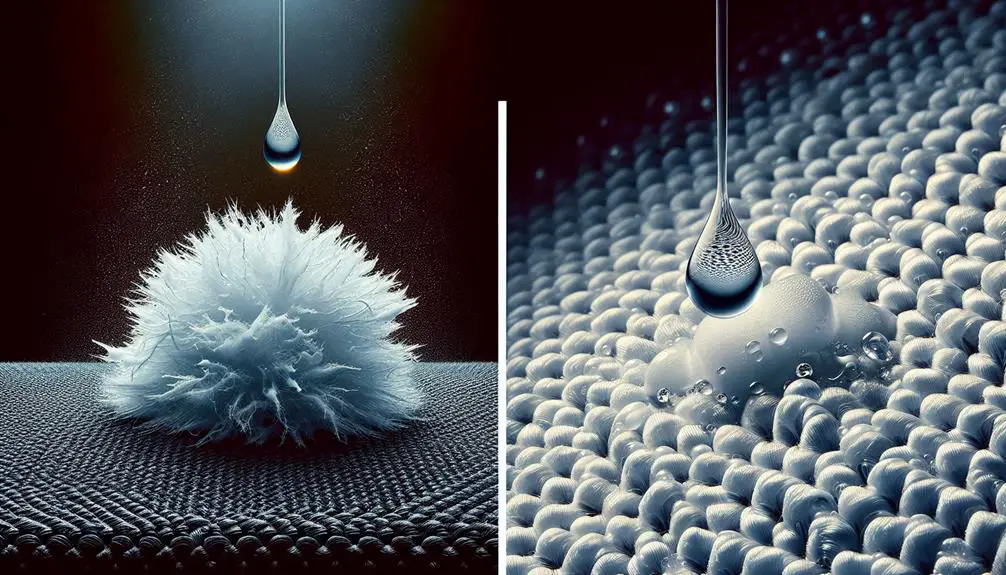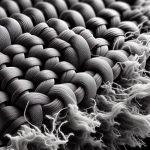Nylon's not really great at soaking up water; it can hold only about 10% of its weight. This makes it pretty non-absorbent, especially compared to something like cotton, which can absorb way more. Nylon's got this tight molecular structure that doesn't really like to hang onto water, which is why it's often used in environments where staying dry is important. They've tried making it more absorbent with special treatments and technology, so it's getting better at handling moisture. If you're curious about how all these tweaks and treatments work, there's more intriguing stuff to uncover on that!
Table of Contents
Key Takeaways
- Nylon naturally repels water due to its hydrophobic molecular structure that lacks polar OH groups.
- It can only hold about 10% of its weight in water, making it less absorbent than natural fibers like cotton.
- Modified nylons with hydrophilic groups or coatings can enhance water absorption for specific applications.
- Nylon garments often receive water-repellent treatments to further prevent water absorption.
- Despite its low natural absorbency, nylon's quick drying time and moisture management treatments make it suitable for performance textiles.
Understanding Nylon's Nature
To really grasp why nylon isn't great at soaking up water, we need to look at its synthetic makeup and how it's structured at the molecular level. Nylon's molecular structure is quite tight-knit, with strong hydrogen bonds forming between the polymer chains. This arrangement leaves fewer spaces or bonding sites for water molecules to latch onto. It's this lack of bonding sites that plays a big role in nylon's low moisture absorbency.
Now, when I say nylon can only hold about 10% of its weight in water, what I'm really highlighting is how this synthetic fiber compares to more absorbent materials like cotton. Cotton's structure, unlike nylon, has ample bonding sites that attract and retain moisture. This characteristic makes cotton feel damper and stay wet longer, unlike nylon which tends to remain more surface dry.
Understanding this, it's clear that nylon's inherent properties make it less desirable for situations where high absorbency is key. However, its low water retention also translates into quicker drying times, which can be a plus in many scenarios where staying dry is more beneficial.
Nylon's Hydrophobic Properties
Nylon's hydrophobic properties mean it naturally repels water, making it less absorbent than materials like cotton. This is because the molecular structure of nylon lacks polar OH groups, which are crucial for forming hydrogen bonds with water molecules. Without these bonds, there's a decreased capacity for moisture absorption, which explains why nylon can only soak up about 10% of its weight in water.
This low absorbency is a significant factor in why nylon is favored in environments where moisture is a concern. For instance, in outdoor gear and rainwear, you wouldn't want your materials soaking up water and becoming heavy or uncomfortable. Nylon's ability to resist water without heavy chemical treatments makes it an ideal choice for such applications.
Understanding these characteristics helps clarify why nylon behaves the way it does around water. It's not just about being not very thirsty; it's about being practically resistant to water at a molecular level. So, if you're looking for something that keeps moisture at bay, nylon's your go-to. This inherent resistance to water is what makes nylon stand out in the lineup of synthetic fibers where performance in wet conditions is critical.
Enhancing Nylon's Absorbency
While it's true that nylon naturally repels water, scientists have developed ways to boost its absorbency. By tweaking the molecular structure of nylon, they've managed to incorporate hydrophilic groups, which significantly enhance its ability to soak up water. This means that these modified nylons can now attract and hold water molecules much more effectively than traditional nylon.
With surface treatments, the game changes even more. These treatments can add a layer to the nylon that not only increases water absorption but does so without compromising the material's inherent strengths. It's a bit like giving nylon a new skin, one that loves water rather than repelling it.
Moreover, by mixing in certain fillers or additives, the absorbency of nylon can be customized. This is crucial for applications where moisture management is key—think breathable athletic wear or moisture-wicking fabrics. The ability to engineer nylon for specific absorbency levels opens up a whole new world of possibilities in textile and material science.
Treatments for Moisture Management
Now, let's talk about how we can manage moisture in nylon fabrics.
One way is by applying hydrophilic coatings, which actually attract water to enhance the fabric's ability to manage moisture.
Another method involves integrating wicking technologies that pull moisture away from the body, keeping you dry and comfortable.
Hydrophilic Coatings Application
Applying hydrophilic coatings to nylon significantly boosts its ability to absorb moisture. These specialized coatings alter the surface of nylon, making it more hydrophilic—basically, it's more friendly towards water.
This means the treated nylon can attract and hold onto water much better than its untreated counterpart. It's a pretty neat trick for materials that need to manage moisture effectively, like in sportswear or outdoor gear.
By enhancing the hydrophilic properties of nylon, these coatings ramp up its overall moisture absorption. It's a straightforward solution that taps into surface science to solve real-world problems.
Wicking Technologies Integration
Building on the idea of hydrophilic coatings, integrating wicking technologies into nylon further enhances its ability to manage moisture effectively. These treatments aren't just about altering how nylon looks but seriously upgrading its performance.
By tweaking the surface properties of nylon, these technologies make it more adept at moisture wicking, which means they add hydrophilic properties that weren't originally part of nylon's makeup. This shift doesn't just slightly improve how nylon handles sweat and dampness; it transforms it into a quick-drying, comfort-enhancing fabric ideal for active wear and other demanding uses.
Integrating such wicking technologies really pushes nylon from being just another synthetic to a high-performance choice in textiles where moisture management is key.
Comparing Nylon With Natural Fibers
When comparing nylon to natural fibers like cotton, it's clear that nylon is significantly less absorbent. Here's why: cotton, a natural fiber, can soak up about 25 times its weight in water. That's massive! Now, nylon, on the other hand, only manages to hold about 10% of its weight in water. The main reason behind this difference lies in their molecular structures. Cotton has tons of bonding sites that are just perfect for water to latch onto. Nylon? Not so much.
This difference in absorbency isn't just a trivial fact; it influences how we use these materials in everyday life. Think about it; you wouldn't grab a nylon towel after a shower. It's always cotton. That's because you need something that really sucks up the moisture. Plus, nylon garments often get a water-repellent treatment to further prevent water absorption, which is a stark contrast to how we maximize the absorbency of cotton in items like towels.
Impact of Moisture on Nylon
Let's talk about how nylon interacts with moisture.
First, we'll look at how quickly nylon can absorb water, which really affects its overall properties.
Then, we'll explore why nylon isn't very water-loving but can still get wet.
Nylon Moisture Absorption Rate
Nylon absorbs about 10% of its weight in water, which enhances its impact resistance, flexibility, and toughness. When water gets into nylon, it bonds with water molecules. This bonding is a type of plasticization, which, while it lowers the overall strength, significantly ups the flexibility. This interplay clearly boosts the impact strength of the material.
Different nylon grades show varied water absorption rates, which means their performance can differ quite a bit under similar conditions. If you're dealing with moisture-laden nylon, drying it out for a couple of hours can usually reset its properties. It's a simple fix that restores its strength and reduces any temporary gains in flexibility from the absorbed moisture.
Nylon's Hydrophobic Properties
Despite its hydrophobic nature, nylon's performance can change significantly when it absorbs moisture. While nylon doesn't soak up water like a sponge, it does take in moisture, impacting its mechanical properties. It's a bit of a paradox, really; a material that repels water but still changes when it gets wet.
Here's a quick breakdown of how moisture affects nylon:
| Impact | Description |
|---|---|
| Strength Reduction | Moisture acts as a plasticizer, reducing nylon's strength. |
| Flexibility Increase | Absorbed water increases flexibility. |
| Performance Variability | Different grades show different reactions to moisture. |
| Comparative Absorption | Less absorbent than cotton, but not completely resistant. |
| Hydrophobic Properties | Water is repelled, but not entirely prevented from entering. |
Drying Time for Nylon
Understanding how quickly nylon dries after getting wet is key to managing its moisture-related changes. Although nylon doesn't absorb moisture as readily as natural fibers, it does take in some, depending on its grade.
When it gets wet, just giving it 2-3 hours to dry can effectively mitigate the effects of this absorption. This quick drying time is particularly beneficial, considering that increased temperature can lead to more water absorption, affecting the nylon's properties like impact resistance, flexibility, and toughness.
Therefore, selecting the right nylon grade becomes crucial, especially if you're dealing with environments that have high humidity. Each grade varies significantly in how much moisture it can absorb, which in turn, impacts its overall performance.
Measuring Nylon's Moisture Absorption
To accurately gauge how much moisture nylon absorbs, it's crucial to consider several variables like temperature and humidity. When I look into this, I see that moisture absorption in nylon isn't just about how much water it can hold; it's about understanding how water molecules interact with nylon polymer chains. This interaction can significantly impact the material's mechanical properties, such as strength and stiffness.
Here are key measures to understand this interaction:
- Temperature and Humidity Levels: Higher temperatures often increase the rate at which nylon absorbs moisture. Similarly, high humidity environments lead to more moisture absorption compared to drier conditions. These factors need to be precisely controlled during testing to get accurate results.
- Material Crystallinity: Nylons with higher crystallinity generally absorb less moisture. It's important to note the type of nylon being tested, as this influences how tightly packed the polymer chains are, hence affecting moisture uptake.
- Exposure Duration: The length of time nylon is exposed to moisture-rich environments can determine how much water it absorbs. Longer exposure periods usually mean more absorption, altering the polymer's physical properties.
Grasping these variables helps us understand not just how much water nylon can absorb, but also how it affects the material's overall behavior and performance.
Applications in Textile Industry
Nylon's unique properties make it a standout choice for the textile industry, especially in crafting items like jackets and performance wear. This synthetic fabric isn't just about looking good; it's about practicality. Due to its water-resistant nature, nylon is a top pick for outdoor gear. You won't find yourself soaked because this material does a stellar job at repelling water, making it ideal for anyone who's into hiking or camping.
Beyond just keeping you dry, nylon's durability is something to talk about. It's tough enough to handle serious wear and tear without giving up on you. This makes it perfect for travel bags and heavy-duty carpets that see a lot of foot traffic. Plus, nylon's lightweight feel means you won't feel weighed down, whether it's a jacket you're wearing or a bag you're carrying.
And here's the kicker: nylon is super versatile. By blending it with other fibers, manufacturers can boost both comfort and performance. So, whether you're looking for function, durability, or just a sleek look, nylon's got you covered. It truly strikes a balance that few other textiles can match, making it a smart choice for a wide range of applications.
Future of Absorbent Nylon Fabrics
Researchers are pushing the boundaries to develop nylon fabrics that could soon rival the absorbency of natural fibers like cotton. With innovations focusing on altering the molecular structure of nylon, there's a real buzz around how these changes could boost water absorption. This isn't just about making slightly better nylon; it's about transforming the fabric into something that can truly stand toe-to-toe with the likes of cotton in terms of soaking up moisture.
Here's what's on the horizon for nylon:
- Molecular Tweaks: Scientists are diving deep into the molecular structure of nylon, aiming to enhance its hydrophilic properties. This means they're figuring out ways to make the nylon fibers attract more water molecules.
- Surface Treatments: Beyond the molecular level, there are advances in surface treatments that apply hydrophilic coatings to the nylon fibers, significantly increasing their ability to absorb water.
- Fiber Engineering: The shape and arrangement of the fibers are being re-engineered to maximize exposure to water, which could lead to faster and more efficient water absorption.
These advancements aren't just about making wetter nylons; they're about creating a material that's both highly absorbent and durable, opening up new possibilities for industries that need these properties.
Frequently Asked Questions
Is Nylon an Absorbent Material?
No, I wouldn't consider nylon an absorbent material. It holds just about 10% of its weight in water, which is far less than cotton. It's essentially hydrophobic, unlike the hydrophilic nature of cotton.
Does Nylon Absorb a Lot of Water?
No, nylon doesn't absorb a lot of water. It can hold only about 10% of its weight in water, making it less absorbent than natural fibers like cotton, which are more water-friendly.
Why Nylon Does Not Absorb Water?
Nylon doesn't absorb much water because its molecules lack OH groups, which bond with water. It's designed this way, often treated to repel water, making it less absorbent than natural fibers like cotton.
What Happens When Nylon Gets Wet?
When nylon gets wet, it undergoes plasticization, where water molecules bond with nylon chains. This process increases its flexibility, impact resistance, and toughness, but can also change its size and overall properties.
- Tetron Fabric for Marine Applications: Durability and Use Cases - June 18, 2025
- Tetron Fabric for Outdoor Furniture: Weather Resistance and Care - June 18, 2025
- Tetron Fabric for Wall Coverings: Style and Application Tips - June 18, 2025







